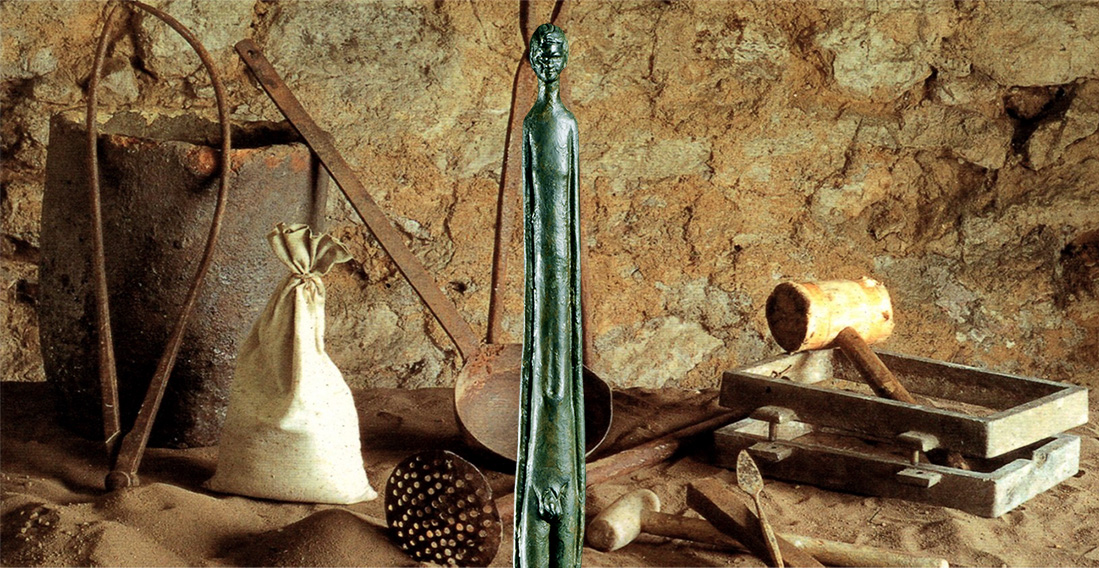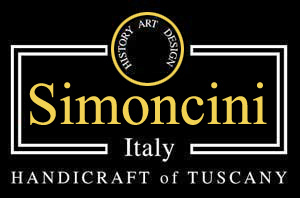
A Volterra oltre 2000 anni fa esisteva l'officina altamente specializzata dell'Etruria centro-settentrionale, dedita all'esecuzione di sculture di forma allungata di età tardo-classica ed ellenistica. Ancora oggi il laboratorio Simoncini, in un tempo saturo di prodotti destinati al rapido consumo senza storia e senza memoria, produce con la maggiore sapienza artigiana toscana una produzione di sculture artigianali, fatta di cura speciale per l'oggetto, di attenzione ferma per il dettaglio e la rifinitura, di un processo d'invecchiamento speciale e gelosamente custodito, che producono un oggetto antico e moderno nello stesso tempo.
L'Ombra della sera è una statuetta votiva etrusca proveniente dall'antica Velathri ovvero l'attuale Volterra, conservata al museo Guarnacci (Efebo Allungato 300-250 a.C. periodo Ellenico). Rappresenta una figura maschile nuda ma ciò che risalta maggiormente è la forma allungata del corpo, stile che risulta moderno per una scultura etrusca, in questa figura viene sottolineata la bellezza grazie ai tratti naturali del volto. I bronzisti di Volterra erano già noti nell'antichità per le grandi capacità manifatturiere e tecnologiche, che permettevano loro di fondere i minerali di rame con lo stagno, ottenendo il bronzo.
Le forme dell’Ombra della sera sono particolarmente innovative e la forma incredibilmente allungata, mantiene nella sua anatomia le proporzioni di base che non si addice alle fattezze degli altri reperti etruschi ritrovati, infatti confrontando L’Ombra della sera con questi altri ritrovamenti si avverte una diversità estetica. Grazie ai laboratori dell’Istituto di fisica applicata del Cnr con l’impiego di laser particolari realizzati dai ricercatori del laboratorio, i raggi di luce rivelatori hanno illuminato i segreti dell’Efebo allungato. La statua è stata forgiata dagli Etruschi e per millenni è rimasta interrata prima d’essere scoperta. Quest' analisi ha confermato che la composizione della statuetta è compatibile con la composizione delle statuette bronzee di epoca etrusca.
Prestigiose testimonianze della storia millenaria di Volterra costituiscono il motivo fondamentale del fascino che la città esercita su coloro che la visitano, città dell'artigianato e gemma dell'arte etrusca e romana. L'attività dei forni fusori è sicuramente documentata fin dal periodo etrusco da un'abbondante produzione di oggettistica di alta qualità, in quanto valenti artigiani circolavano a Volterra introducendo di volta in volta nuovi modelli che, elaborati all'interno delle botteghe locali, offrivano una peculiare interpretazione della tendenza all'allungamento della figura umana.
Dopo quasi 3000 anni il sangue degli etruschi è ancora presente nei Toscani, esaminando il DNA di persone originarie della Toscana sono state individuate particolarità uniche non riscontrabili nel resto d’Italia. Quest’affascinante ipotesi proverebbe che l’eredità etrusca, attraverso i millenni è arrivata fino a noi in quanto la Toscana non essendo stata terra di grandi mutazioni etniche, la popolazione ha conservato nei secoli una relativa stabilità.
Gli Etruschi avevano trovato il modo di godersi la vita che sapevano allietare con feste, giochi, banchetti, trasmettendo l’immagine di una società operosa, raffinata.

In Volterra, more than 2000 years ago, there was the highly specialized workshop of the central-northern Etruria, dedicated to the execution of sculptures of elongated form of the late Classical and Hellenistic ages. Even today the Simoncini laboratory, in a time saturated with products destined to the rapid consumption without history and without memory, produces with the greatest Tuscan craftsmanship a production of handmade sculptures, made of special care for the object, of firm attention to detail and refinement, of a special aging process and jealously guarded, which produce an ancient and modern object at the same time.
The Shadow of the evening is an Etruscan votive statuette coming from the ancient Velathri that is the current Volterra, conserved to the museum Guarnacci (Efebo Allungato 300-250 B.C. Hellenic period). It represents a naked male figure but what stands out most is the elongated shape of the body, a style that is modern for an Etruscan sculpture, in this figure is emphasized beauty thanks to the natural features of the face. The bronzers of Volterra were already known in ancient times for their great manufacturing and technological capabilities, which allowed them to melt copper minerals with tin, obtaining bronze.
The shapes of the Shadow of the evening are particularly innovative and the shape incredibly elongated, maintains in its anatomy the basic proportions that does not fit the features of the other Etruscan finds, In fact, by comparing L'Ombra della sera with these other findings, one feels an aesthetic diversity. Thanks to the laboratories of the Institute of Applied Physics of the CNR with the use of special lasers made by researchers of the laboratory, the rays of light detectors have illuminated the secrets of the elongated ephebe. The statue was forged by the Etruscans and remained buried for millennia before being discovered. This analysis confirmed that the composition of the statuette is compatible with the composition of the bronze statuettes of the Etruscan era.
Prestigious testimonies of the ancient history of Volterra are the fundamental reason of the charm that the city exerts on those who visit it, city of craftsmanship and gem of Etruscan and Roman art. The activity of the melting furnaces is certainly documented since the Etruscan period by an abundant production of high quality objects, as skilled craftsmen circulated in Volterra introducing new models that, elaborated within the local workshops, offered a peculiar interpretation of the tendency to the lengthening of the human figure.
After almost 3000 years the blood of the Etruscans is still present in the Tuscans, examining the DNA of people from Tuscany have been identified unique particularities not found in the rest of Italy. This fascinating hypothesis would prove that the Etruscan heritage, through the millennia has come down to us because Tuscany was not a land of great ethnic mutations, the population has preserved over the centuries a relative stability.
The Etruscans had found a way to enjoy life that they knew how to cheer with parties, games, banquets, transmitting the image of an industrious, refined society.

SIMONCINI STUDIO
Sede legale Via Ricciarelli 39 56048 Volterra - Sede distaccata Z.I. Loc. San Quirico 56048 Volterra
Tel. 0588/85756 - Email: info@simoncini-art.it - www.simoncini-art.it